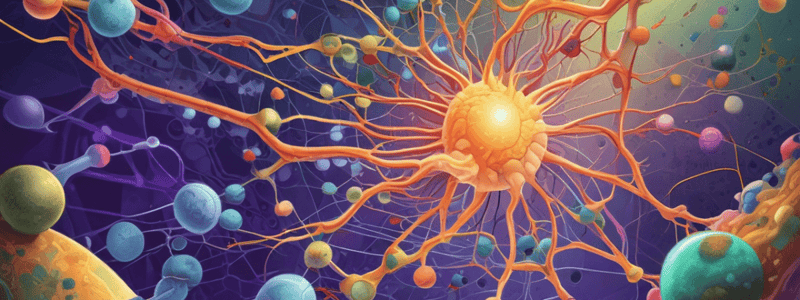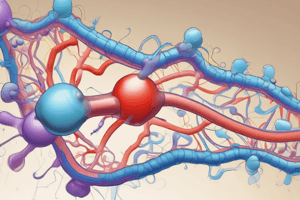Podcast
Questions and Answers
What is the primary function of nuclear receptors?
What is the primary function of nuclear receptors?
- To initiate a signal cascade through G-proteins
- To facilitate ligand-gated ion channel activity
- To regulate gene expression through binding to response elements on DNA (correct)
- To phosphorylate tyrosine residues in response to ligand binding
Which type of receptor is activated by the second messenger inositol-1,4,5-trisphosphate (IP3)?
Which type of receptor is activated by the second messenger inositol-1,4,5-trisphosphate (IP3)?
- Insulin receptor
- Nicotinic receptor
- Ryanodine receptor
- IP3 receptor (correct)
What is the common feature of the structure of Nicotinic R-like, ATP R, and Ionotropic glutamate R receptors?
What is the common feature of the structure of Nicotinic R-like, ATP R, and Ionotropic glutamate R receptors?
- All have 7 transmembrane helices
- All have multiple subunits with transmembrane helices (correct)
- All have a zinc finger structure
- All have 4 transmembrane helices
Which receptor type is characterized by the presence of 2, 7 transmembrane helices connected by intra- and extracellular loops?
Which receptor type is characterized by the presence of 2, 7 transmembrane helices connected by intra- and extracellular loops?
What is the primary function of receptor tyrosine kinases (RTKs)?
What is the primary function of receptor tyrosine kinases (RTKs)?
Which receptor type is involved in the dynamic process of receptor internalization, recycling, or degradation?
Which receptor type is involved in the dynamic process of receptor internalization, recycling, or degradation?
What is the primary function of G-protein coupled receptors (GPCRs)?
What is the primary function of G-protein coupled receptors (GPCRs)?
Which receptor type is characterized by the presence of 5 subunits each made up of 4 transmembrane helices?
Which receptor type is characterized by the presence of 5 subunits each made up of 4 transmembrane helices?
What is the primary function of IP3 receptor?
What is the primary function of IP3 receptor?
Which receptor type is characterized by the presence of a zinc finger structure?
Which receptor type is characterized by the presence of a zinc finger structure?
What is the primary function of ligand binding to nuclear receptors?
What is the primary function of ligand binding to nuclear receptors?
What is the common feature of the structure of plasma membrane receptors?
What is the common feature of the structure of plasma membrane receptors?
What is the primary function of intracellular membrane receptors?
What is the primary function of intracellular membrane receptors?
Which type of receptor is characterized by the presence of 3 subunits each made up of 2 transmembrane helices?
Which type of receptor is characterized by the presence of 3 subunits each made up of 2 transmembrane helices?
What is the primary function of receptor tyrosine kinases (RTKs)?
What is the primary function of receptor tyrosine kinases (RTKs)?
What is the primary function of receptor guanylate cyclase (RGC)?
What is the primary function of receptor guanylate cyclase (RGC)?
What is the primary function of receptor trafficking?
What is the primary function of receptor trafficking?
Which type of receptor is involved in the regulation of muscle contraction?
Which type of receptor is involved in the regulation of muscle contraction?
What is the primary function of ionotropic glutamate receptors?
What is the primary function of ionotropic glutamate receptors?
What is the primary function of G-protein coupled receptors (GPCRs) in terms of signaling pathways?
What is the primary function of G-protein coupled receptors (GPCRs) in terms of signaling pathways?
What is the common feature of the structure of Nicotinic R-like, ATP R, and Ionotropic glutamate R receptors?
What is the common feature of the structure of Nicotinic R-like, ATP R, and Ionotropic glutamate R receptors?
What is the primary function of receptor tyrosine kinases (RTKs)?
What is the primary function of receptor tyrosine kinases (RTKs)?
Which type of receptor is characterized by the presence of a zinc finger structure?
Which type of receptor is characterized by the presence of a zinc finger structure?
What is the primary function of IP3 receptor?
What is the primary function of IP3 receptor?
What is the primary function of receptor guanylate cyclase (RGC)?
What is the primary function of receptor guanylate cyclase (RGC)?
Which type of receptor is characterized by the presence of 3 subunits each made up of 2 transmembrane helices?
Which type of receptor is characterized by the presence of 3 subunits each made up of 2 transmembrane helices?
What is the primary function of receptor trafficking?
What is the primary function of receptor trafficking?
Which type of receptor is involved in the regulation of muscle contraction?
Which type of receptor is involved in the regulation of muscle contraction?
What is the primary function of G-protein coupled receptors (GPCRs)?
What is the primary function of G-protein coupled receptors (GPCRs)?
What is the primary function of nuclear receptors?
What is the primary function of nuclear receptors?
Flashcards are hidden until you start studying
Study Notes
Pharmacological Receptors
- Specialised proteins located on the cell surface or within the cell that bind to ligands to initiate a signal cascade
- Can be classified into three main categories: nuclear receptors, plasma membrane receptors, and intracellular receptors
Nuclear Receptors
- Located within the cell nucleus
- Examples: oestrogen receptor, retinoic acid receptor
- Structure: zinc finger structure
- Function: upon ligand binding, binds to response elements on DNA to regulate gene expression
Intracellular Receptors
- Found inside the cell
- Locations: sarcoplasmic reticulum (muscle), endoplasmic reticulum (neurones and other cells)
- Examples: Ryanodine receptor, IP3 receptor
- Ryanodine receptor: activated by Ca2+ and other modulators
- IP3 receptor: activated by the second messenger inositol-1,4,5-trisphosphate (IP3)
Plasma Membrane Receptors
- Located on the cell surface
- Superfamilies: Ligand-gated ion channels, G-protein coupled receptors, Intrinsic enzyme receptors
Ligand-Gated Ion Channels
- Types: Nicotinic R-like, ATP R, Ionotropic glutamate R
- Nicotinic R-like: 5 subunits, each with 4 transmembrane helices
- ATP R: 3 subunits, each with 2 transmembrane helices
- Ionotropic glutamate R: 4 subunits, each with 3 transmembrane helices
- Function: binding of ligand causes depolarisation or hyperpolarisation
G-Protein Coupled Receptors
- Types: Rhodopsin-like, mGLUR
- Rhodopsin-like: 7 transmembrane helices
- mGLUR: 2, 7 transmembrane helices connected by intra- and extracellular loops
- Function: activate intracellular signalling pathways through interaction with G-proteins
Intrinsic Enzyme Receptors
- Types: receptor tyrosine kinases (RTK), receptor guanylate cyclase (RGC)
- RTK: extra-cellular binding site with intra-cellular tyrosine kinase domain
- RGC: extra-cellular binding site with intra-cellular guanylyl cyclase domain
- Function: dimerisation leads to phosphorylation or production of second messenger
Receptor Trafficking
- Involves dynamic process of receptor internalisation, recycling, or degradation
- Plays a crucial role in signal termination and cellular adaptation
Pharmacological Receptors
- Specialised proteins located on the cell surface or within the cell that bind to ligands to initiate a signal cascade
- Can be classified into three main categories: nuclear receptors, plasma membrane receptors, and intracellular receptors
Nuclear Receptors
- Located within the cell nucleus
- Examples: oestrogen receptor, retinoic acid receptor
- Structure: zinc finger structure
- Function: upon ligand binding, binds to response elements on DNA to regulate gene expression
Intracellular Receptors
- Found inside the cell
- Locations: sarcoplasmic reticulum (muscle), endoplasmic reticulum (neurones and other cells)
- Examples: Ryanodine receptor, IP3 receptor
- Ryanodine receptor: activated by Ca2+ and other modulators
- IP3 receptor: activated by the second messenger inositol-1,4,5-trisphosphate (IP3)
Plasma Membrane Receptors
- Located on the cell surface
- Superfamilies: Ligand-gated ion channels, G-protein coupled receptors, Intrinsic enzyme receptors
Ligand-Gated Ion Channels
- Types: Nicotinic R-like, ATP R, Ionotropic glutamate R
- Nicotinic R-like: 5 subunits, each with 4 transmembrane helices
- ATP R: 3 subunits, each with 2 transmembrane helices
- Ionotropic glutamate R: 4 subunits, each with 3 transmembrane helices
- Function: binding of ligand causes depolarisation or hyperpolarisation
G-Protein Coupled Receptors
- Types: Rhodopsin-like, mGLUR
- Rhodopsin-like: 7 transmembrane helices
- mGLUR: 2, 7 transmembrane helices connected by intra- and extracellular loops
- Function: activate intracellular signalling pathways through interaction with G-proteins
Intrinsic Enzyme Receptors
- Types: receptor tyrosine kinases (RTK), receptor guanylate cyclase (RGC)
- RTK: extra-cellular binding site with intra-cellular tyrosine kinase domain
- RGC: extra-cellular binding site with intra-cellular guanylyl cyclase domain
- Function: dimerisation leads to phosphorylation or production of second messenger
Receptor Trafficking
- Involves dynamic process of receptor internalisation, recycling, or degradation
- Plays a crucial role in signal termination and cellular adaptation
Pharmacological Receptors
- Specialised proteins located on the cell surface or within the cell that bind to ligands to initiate a signal cascade
- Can be classified into three main categories: nuclear receptors, plasma membrane receptors, and intracellular receptors
Nuclear Receptors
- Located within the cell nucleus
- Examples: oestrogen receptor, retinoic acid receptor
- Structure: zinc finger structure
- Function: upon ligand binding, binds to response elements on DNA to regulate gene expression
Intracellular Receptors
- Found inside the cell
- Locations: sarcoplasmic reticulum (muscle), endoplasmic reticulum (neurones and other cells)
- Examples: Ryanodine receptor, IP3 receptor
- Ryanodine receptor: activated by Ca2+ and other modulators
- IP3 receptor: activated by the second messenger inositol-1,4,5-trisphosphate (IP3)
Plasma Membrane Receptors
- Located on the cell surface
- Superfamilies: Ligand-gated ion channels, G-protein coupled receptors, Intrinsic enzyme receptors
Ligand-Gated Ion Channels
- Types: Nicotinic R-like, ATP R, Ionotropic glutamate R
- Nicotinic R-like: 5 subunits, each with 4 transmembrane helices
- ATP R: 3 subunits, each with 2 transmembrane helices
- Ionotropic glutamate R: 4 subunits, each with 3 transmembrane helices
- Function: binding of ligand causes depolarisation or hyperpolarisation
G-Protein Coupled Receptors
- Types: Rhodopsin-like, mGLUR
- Rhodopsin-like: 7 transmembrane helices
- mGLUR: 2, 7 transmembrane helices connected by intra- and extracellular loops
- Function: activate intracellular signalling pathways through interaction with G-proteins
Intrinsic Enzyme Receptors
- Types: receptor tyrosine kinases (RTK), receptor guanylate cyclase (RGC)
- RTK: extra-cellular binding site with intra-cellular tyrosine kinase domain
- RGC: extra-cellular binding site with intra-cellular guanylyl cyclase domain
- Function: dimerisation leads to phosphorylation or production of second messenger
Receptor Trafficking
- Involves dynamic process of receptor internalisation, recycling, or degradation
- Plays a crucial role in signal termination and cellular adaptation
Studying That Suits You
Use AI to generate personalized quizzes and flashcards to suit your learning preferences.




